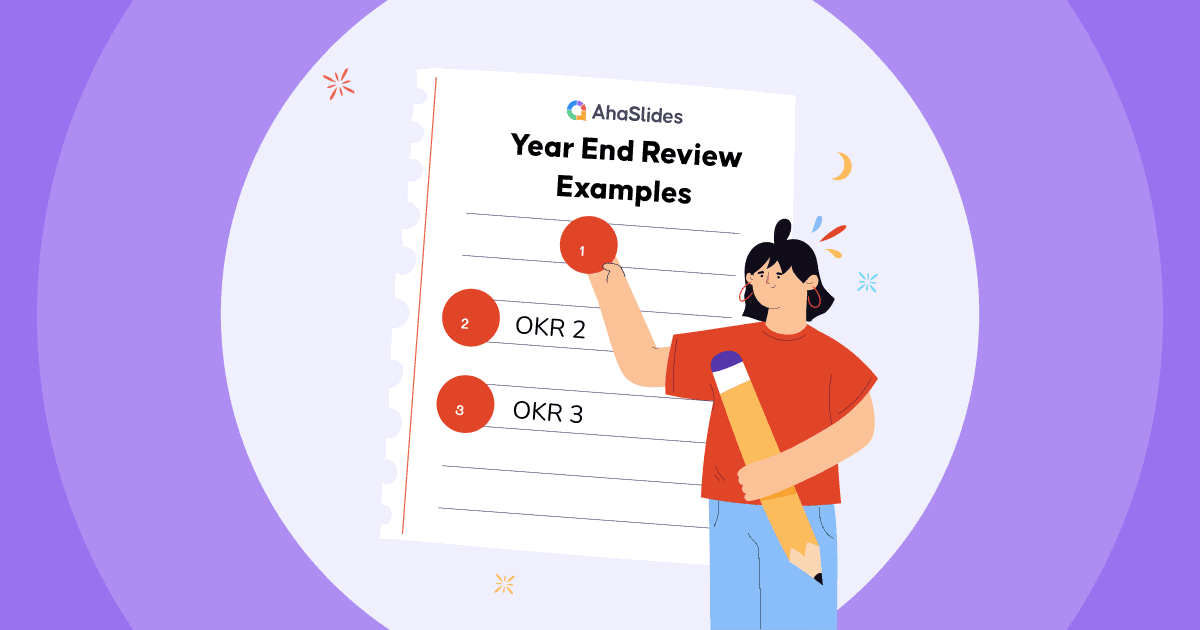자동차 가격 흥정, 연봉 인상 협상, 심지어 기념품을 사려고 노점상과 흥정을 해야 했던 경험이 있으신가요? 그렇다면, 분배 교섭, 고정 자원 분할에 중점을 둔 근본적인 협상 전략입니다.
이 블로그 게시물에서는 분배적 협상이 무엇인지, 그리고 일상적인 사례들을 살펴보고, 통합적 협상과 어떻게 다른지 알아보겠습니다. 또한, 분배적 상황에서 더욱 효과적인 협상가가 되는 데 도움이 되는 필수적인 전략과 전술도 자세히 살펴보겠습니다.
차례

더 나은 참여를 위한 팁

모임 중에 더 많은 재미를 찾고 계십니까?
AhaSlides에서 재미있는 퀴즈로 팀원들을 모아보세요. AhaSlides 템플릿 라이브러리에서 무료 퀴즈에 참여하려면 가입하세요!
🚀 무료 퀴즈 받기☁️
분배 교섭이란 무엇입니까?
분배 교섭은 둘 이상의 당사자가 고정되거나 제한된 자원을 서로 나누는 것을 목표로 하는 협상 전략입니다. 피자를 여러 조각으로 나누어야 하고 모두가 더 큰 조각을 원하는 시나리오로 생각하십시오. 분배 교섭에서는 자신에게 가장 좋은 거래를 얻으려고 노력하면서 파이의 몫을 최대화하는 것이 아이디어입니다.
간단히 말해서, 누가 무엇을 가져갈지 줄다리기를 하는 것과 같습니다. 이러한 유형의 협상은 종종 이해관계가 충돌하는 상황을 수반하는데, 한쪽이 이익을 얻으면 다른 쪽은 손해를 볼 수 있습니다. 이는 승패가 갈리는 상황으로, 한쪽이 더 많이 얻을수록 다른 쪽의 이익은 줄어듭니다.
분배 교섭과 통합 교섭
분배 교섭 시장에서 가격을 놓고 흥정하거나 고용주와 급여 인상 협상을 하는 등 자신의 몫을 요구하는 것입니다. 많이 받을수록 상대방이 받는 금액은 줄어듭니다.
통합교섭, 반면에 시장을 확대하는 것과 비슷합니다. 당신과 당신의 친구가 피자 한 개를 가지고 있지만 페퍼로니, 버섯, 치즈와 같은 추가 토핑도 있다고 상상해보십시오. 기존 피자를 놓고 싸우는 대신, 원하는 대로 토핑을 추가하여 더 좋은 피자를 만들기 위해 함께 노력합니다. 통합 교섭은 양 당사자가 협력하여 전반적인 가치를 높이는 창의적인 솔루션을 찾는 윈윈(win-win) 접근 방식입니다.
즉, 간단히 말해서 분배교섭은 고정된 파이를 나누는 것이고, 통합교섭은 상호 이익이 되는 해결책을 찾아 파이를 더 크게 만드는 것입니다.

분배 교섭의 예
분배적 협상을 더 잘 이해하기 위해 이 협상 전략이 적용되는 몇 가지 실제 사례를 살펴보겠습니다.
#1 – 급여 협상
면접에서 잠재적 고용주와 연봉에 대해 이야기하는 상황을 상상해 보세요. 당신은 더 높은 연봉을 원하고, 고용주는 인건비를 통제하고 싶어 합니다. 이러한 상황은 분배 협상으로, 두 사람 모두 고정된 자원, 즉 당신의 직책에 대한 회사 예산을 두고 경쟁하는 상황입니다. 협상이 성공적으로 진행되면 더 높은 연봉을 받게 되지만, 다른 복리후생이나 특전을 희생해야 할 수도 있습니다.
#2 – 자동차 구매
자동차를 구매하기 위해 대리점을 방문하면 유통 협상을 하게 될 가능성이 높습니다. 판매자는 최대한 낮은 가격을 원하고, 판매자는 수익을 극대화하고자 합니다. 협상은 자동차 가격을 중심으로 진행되며, 양측을 모두 만족시키는 절충안을 찾는 것은 어려울 수 있습니다.
#3 – 이혼 합의
부부가 이혼할 때 재산분할은 전형적인 분배협상 사례라고 할 수 있다. 양 당사자는 부동산, 저축, 투자 등 공유 자산에서 최대한 많은 것을 얻는 데 관심이 있습니다. 협상은 법적 틀과 각 배우자의 이익을 고려하여 이러한 자원을 공정하게 분배하는 것을 목표로 합니다.
이러한 각 예에서 분배 교섭에는 유한하거나 제한된 자원의 몫을 극대화하기 위해 노력하는 당사자가 포함됩니다.
분배 교섭의 전략과 전술

자원이 제한적이고 경쟁적인 분배 협상에서, 신중하게 고안된 전략과 효과적인 전술은 원하는 결과를 달성하는 데 큰 영향을 미칠 수 있습니다. 이러한 유형의 협상에서 사용되는 주요 전략과 전술을 자세히 살펴보겠습니다.
#1 – 위치를 고정하세요
첫 번째 제안은 종종 협상의 방향을 결정하는 기준점 역할을 합니다. 판매자라면 높은 가격으로 시작하세요. 구매자라면 낮은 가격으로 시작하세요. 이는 협상의 분위기를 조성하고 양보의 여지를 남겨줍니다.
#2 – 예약 지점 설정
수락할 수 있는 최저 또는 최고 가격의 기준은 비밀로 하세요. 너무 일찍 공개하면 상대방이 당신의 한계를 알게 되어 유리한 입장에 놓이게 될 수 있습니다.
#3 – 전략적 양보를 하세요
양보할 때는 선택적이고 전략적으로 하라. 너무 빨리 너무 많은 것을 포기하지 마십시오. 점진적인 양보는 자신의 입장을 유지하면서 유연성을 나타낼 수 있습니다.
#4 – 플린치를 사용하세요
제안이 오면 채용하세요. 움찔 전술. 상대방이 제안의 공정성에 의문을 제기하도록 놀라움이나 우려로 반응하십시오. 이는 제안을 개선하도록 유도할 수 있습니다.
#5 – 정보는 힘이다
주제와 상대방의 입장을 철저히 조사하십시오. 지식은 분배 협상에서 귀중한 무기입니다. 정보가 많을수록 효과적인 협상을 할 수 있는 준비가 더 잘 갖춰집니다.
#6 – 마감일을 정하세요
시간 압박은 가치 있는 전략이 될 수 있습니다. 예를 들어 계약 협상을 할 때, 거래 체결 기한을 정하면 상대방이 더 빠른 결정을 내리도록 유도할 수 있으며, 이는 잠재적으로 당신에게 유리하게 작용할 수 있습니다.

#7 – 제한된 권한 사용
의사 결정 권한이 제한되어 있다고 주장하세요. 이는 당신이 최종 결정권자가 아니라는 인상을 주기 때문에 효과적인 전략이 될 수 있습니다. 또한, 상대방이 더 높은 권한을 가진 사람의 승인을 얻기 위해 더 많은 것을 제안하도록 유도할 수도 있습니다.
#8 – 좋은 경찰, 나쁜 경찰
팀으로 협상할 때는 '좋은 경찰, 나쁜 경찰' 전략을 고려해 보세요. 한 협상자는 강경한 입장을 취하는 반면, 다른 협상자는 보다 타협적인 태도를 보입니다. 이는 혼란을 야기하고 양보를 유도할 수 있습니다.
#9 – 필요할 때는 물러나세요
상대방이 당신의 최소 요구 사항을 충족할 의향이 없다는 것이 분명하다면 협상에서 발을 뺄 준비를 하십시오. 때로는 협상 테이블을 떠나는 것이 가장 효과적인 전략일 수 있습니다.
주요 요점
분배 협상은 여러분의 무기고에 꼭 있어야 할 귀중한 기술입니다. 벼룩시장에서 흥정을 하든, 급여 인상을 협상하든, 사업 거래를 성사시키든, 분배 협상의 전략과 전술을 이해하면 자신이나 조직을 위해 최선의 결과를 얻는 데 도움이 될 수 있습니다.
협상 기술을 연마하든, 효과적인 프레젠테이션을 제공하든, 영업팀이 성공하도록 훈련하든, 다음의 잠재력을 고려하십시오. 아하 슬라이드 당신의 성공을 향한 여정을 응원합니다. 우리의 콘텐츠를 한 단계 더 발전시키세요 대화형 템플릿 다양한 요구와 산업에 맞는 제품입니다. 청중은 당신에게 감사할 것입니다.
자주 묻는 질문들 (FAQ)
분배교섭과 통합교섭이란 무엇입니까?
분배 교섭: 이것은 마치 파이를 나누는 것과 같습니다. 당사자들은 고정된 자원을 두고 경쟁하며, 한쪽이 이익을 얻으면 다른 쪽은 손해를 볼 수 있습니다. 이는 종종 승패로 여겨집니다.
통합 교섭: 이를 파이를 키우는 것으로 생각해 보세요. 당사자들은 협상 대상 자원의 전반적인 가치를 높이는 창의적인 해결책을 찾기 위해 협력합니다. 일반적으로 윈윈(win-win)입니다.
분배교섭은 윈윈(win-win)인가?
분배 협상은 일반적으로 양쪽 모두에게 이로운 상황이 아닙니다. 오히려 한쪽의 이득이 다른 쪽의 손실을 가져오는, 즉 양쪽 모두에게 이로운 상황으로 이어지는 경우가 많습니다.
참고 : 경제 타임즈 | 아메리칸 익스프레스








